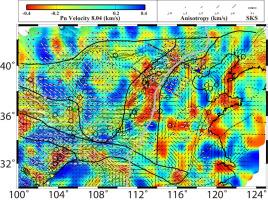Updated Pn-wave anisotropic tomography and dynamics of the North China Craton
IF 2.6
3区 地球科学
Q2 GEOCHEMISTRY & GEOPHYSICS
引用次数: 0
Abstract
We determine detailed Pn-wave anisotropic tomography of the uppermost mantle beneath the North China Craton (NCC) and its surrounding areas by inverting 84,771 manually-picked Pn-wave arrival times of 2864 local earthquakes recorded at 586 seismic stations. Our results reveal significant lateral heterogeneities in both Pn-wave velocity and anisotropy. A low-velocity (low-V) anomaly exists in the uppermost mantle north of the Ordos block, indicating that the lithosphere has been partially destroyed there, probably associated with the eastward extrusion due to the India-Asia collision and/or mantle upwelling caused by the northwestward deep subduction of the Pacific plate. Low-V anomalies appear in the central NCC, being affected by the westward deep subduction of the Pacific plate. High-velocity (high-V) anomalies with a roughly E-W fast propagation direction (FPD) exist on the eastern and western sides of the North China basin (NCB), which may be remnants of lithospheric mantle delamination due to the underplating of basaltic magma. A low-V anomaly with a nearly N-S FPD exists under the central NCB, reflecting compressional deformation there. In the middle segment of the Tanlu fault zone, a high-V anomaly exists to the west and a low-V anomaly appears to the east, whereas the pattern of velocity anomalies is opposite in the southern segment. These results suggest that the NCC destruction could be caused by combined effects of lithospheric delamination and thermal erosion.

华北克拉通更新的p波各向异性层析成像与动力学
本文通过对586个地震台站记录的2864次局部地震的84771次人工采集的地震波到达时间进行反演,确定了华北克拉通及其周边地区上地幔的详细的pn波各向异性层析成像。我们的研究结果揭示了波速和各向异性的显著横向非均质性。鄂尔多斯地块北部上地幔存在低速(低v)异常,表明该地区岩石圈已被部分破坏,可能与印度-亚洲碰撞引起的东挤压和太平洋板块西北深俯冲引起的地幔上升流有关。受太平洋板块西向深俯冲的影响,低电压异常出现在北太平洋中部。华北盆地(NCB)东、西两侧存在大致为东西向的高速异常(high-V),可能是由于玄武岩岩浆底沉降导致岩石圈地幔拆沉的残余。在NCB中央存在一个近北南向FPD的低电压异常,反映了那里的挤压变形。在郯庐断裂带中段,西呈高v异常,东呈低v异常,南段速度异常模式相反。这些结果表明,NCC的破坏可能是岩石圈剥离和热侵蚀共同作用的结果。
本文章由计算机程序翻译,如有差异,请以英文原文为准。
求助全文
约1分钟内获得全文
求助全文
来源期刊

Tectonophysics
地学-地球化学与地球物理
CiteScore
4.90
自引率
6.90%
发文量
300
审稿时长
6 months
期刊介绍:
The prime focus of Tectonophysics will be high-impact original research and reviews in the fields of kinematics, structure, composition, and dynamics of the solid arth at all scales. Tectonophysics particularly encourages submission of papers based on the integration of a multitude of geophysical, geological, geochemical, geodynamic, and geotectonic methods
 求助内容:
求助内容: 应助结果提醒方式:
应助结果提醒方式:


